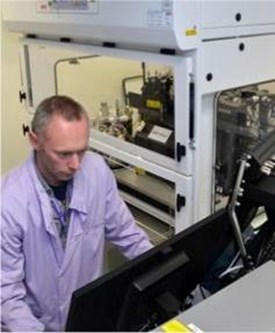Ask a Flow Cytometry Expert: Your Questions Answered
Dr. Gareth Howell, Senior Experimental Officer and Flow Core Facility Manager at the University of Manchester answers your questions.
|
Flow cytometry (FC) is an excellent technique to sort and quantify heterogenous cell populations. Despite its usefulness, FC can be tricky to optimize and there are many different facets to each experiment. Dr. Gareth Howell, Senior Experimental Officer and Flow Core Facility Manager at the University of Manchester, provides his wisdom and experience to answer questions from our customers. We hope that these help you too! (Image right: Dr. Gareth Howell) |
 |
Why is FMO a better control than isotype? How does this control for non-specific antibody binding?
FMO, or fluorescence minus one, controls and isotype controls are different types of controls and aid the experiment in different ways. FMO controls allow you to determine how much spread is occurring between channels following compensation. They allow you to accurately determine where to gate for positive populations of cells by showing how much spread is on the negative population in the context of all the other colors in your experiment.
Isotype controls allow you to determine how much background binding may be occurring due to non-specific binding of the class-matched IgG, in particular to Fc receptors on cells such as monocytes and macrophages. Isotype controls should not be used in FMO controls. Be careful with isotype controls and remember a few points: 1) isotypes are IgG molecules so may show a degree of binding in the system you are using them in, 2) your isotype should carry the same fluorophore as your test antibody but, especially if you are using tandems, is unlikely to be of the same batch of fluorescent molecule complex so may be slightly different, and 3) ensure you are using the same concentration of isotype control as you are using for your test panel – use both at the same µg/mL concentration, not dilution as that is not sufficiently accurate.
When designing a flow panel, how important is it to test the panel as FMOs?
FMO, or fluorescence minus one, controls are used to position gates during your cell analysis. As they contain all of the antibodies in your panel minus one, they allow you to determine how much spread you are getting in the negative population in the context of all of the other fluorochromes and post compensation. They are not factored into the design of the panel but knowing the signal spread matrix (SSM) is related to the FMO controls and is a key consideration in panel design.
What do you advise doing if you have a compensation control (using beads) for which you don’t get a positive and negative peak, but one very wide peak?
First, check the technical aspect of the experiment – are the beads (comp beads) suitable for the species from which the antibody was isolated (not all comp beads are catch-all)?
If this is ok, check the antibody by staining comp beads with an alternative antibody but with a matching fluorochrome. When run at the same voltage do you get a good separation of positive and negative? If the fluorochrome is not a tandem conjugate you could use the alternative antibody as a surrogate (remember, compensation isn’t about the antibody, it’s about the fluorochrome). However, if it is a tandem then it’s advisable to keep using the same antibody as you use on your cells.
Check the voltages on that particular channel. If they have been set by an automated system they may not be ideal. Try performing a titration of the voltages (voltration) to determine a more optimal voltage setting. Increase the voltages in increments of 50 from 200 and watch for the appearance of the positive peak. Once the separation between positive and negative stops increasing then this is your optimal voltage. Optimal voltage should be set in this way using, for example, CD4 stained leukocytes. If this hasn’t addressed the problem, then you could try a titration of antibody on the comp beads. Beads do not need to be stained with the same dilution of antibody as your cells – they may need more or less antibody to give an appropriate signal to allow for accurate compensation to be performed.
What viability dyes do you suggest when you have already used RFP, GFP, and blue laser?
There are a few options here and they may depend on the application and whether you are planning to fix the cells. If you are running unfixed samples then reagents such as 7AAD or Draq7 would work for you. These dyes emit in the far-red region of the spectrum, far away from the fluorescent proteins you are referring to. If you are planning to fix your cells, there are amine-reactive fixable viability dyes that emit in the far red, an example of this is the Zombie-NIR (Biolegend) and Proteintech’s Phantom Dye Red 780 Viability Dye. These are sensitive as there is little background from the autofluorescence of the live cells. They can also be used on live cells if you are planning to perform cell sorting, for example.
When should I titrate an antibody and what is the recommended protocol for flow antibody titrations?
You should always titrate your antibodies when they are new to the panel, new to the system (e.g., a change in cell type), or if you have changed the fluorochrome. Titrations should be done on a 6- or 8-point scale starting from very low concentrations of antibody up to saturation of the antigen. Titrations should be done on the cells you are planning to stain later on. They should also be performed on a set number of cells that reflect the number of cells you plan to stain in your full experiment. Titrations can be performed in a two-stage strategy, whereby the lineage markers are titrated initially, then the secondary markers are titrated subsequently.
For more information on Flow Cytometry in general, please see our Complete Guide to Flow Cytometry.
Related Content
Flow cytometry multicolor panel design
Experimental protocol to study cell viability and apoptosis
DOWNLOAD: Antibodies for Flow cytometry




